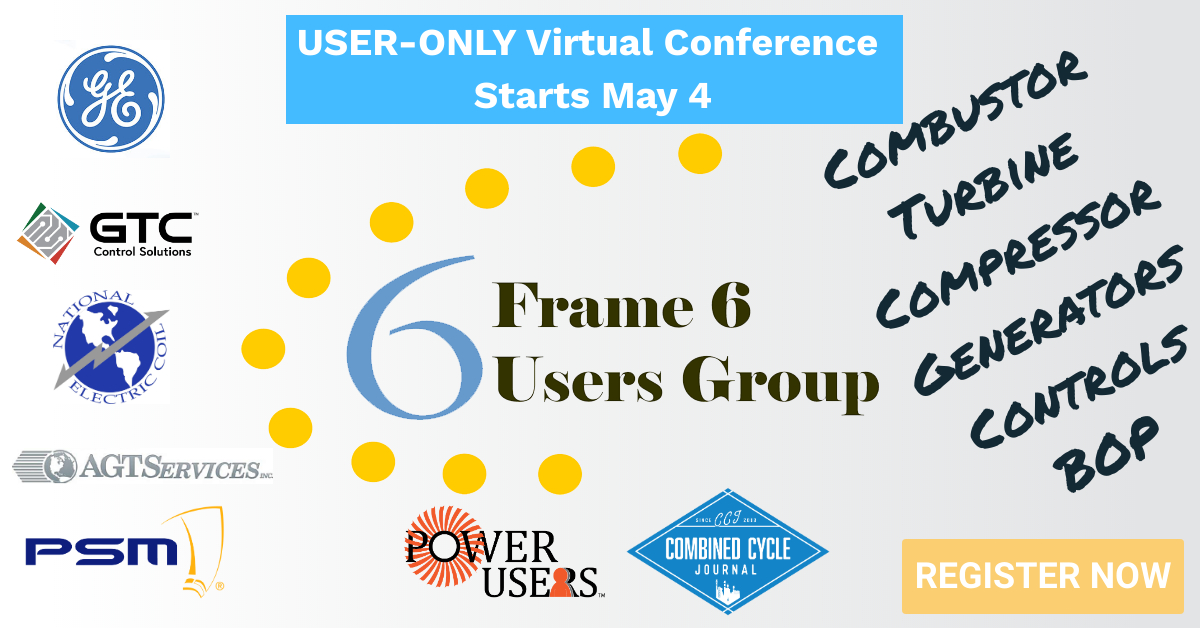 Perhaps no one understands your job-related challenges better than colleagues with the same engine. That’s what makes the Frame 6 Users Group’s compressor, turbine, combustion, and I&C roundtables particularly valuable. These sessions allow you to describe issues of concern to fellow users and let them suggest possible solutions based on their experiences. Think of it as free consulting provided by the industry’s top O&M experts.
Perhaps no one understands your job-related challenges better than colleagues with the same engine. That’s what makes the Frame 6 Users Group’s compressor, turbine, combustion, and I&C roundtables particularly valuable. These sessions allow you to describe issues of concern to fellow users and let them suggest possible solutions based on their experiences. Think of it as free consulting provided by the industry’s top O&M experts.
While no safety roundtable is scheduled for the 2021 conference, be aware that there are several safety threads posted to the organization’s online forum, hosted on the Power Users website—including experience with optical flame detectors, how to deal with ill-fitting compartment doors and hardware replacements to correct, functional tests to confirm proper operation of water-mist fire-suppression systems during unit commissioning, opening of compartment doors with the CO2 system activated, etc.
Another way to come up to speed on the safety aspects of Frame 6 O&M is to become familiar with the OEM’s safety-related Technical Information Letters (TILs) and Product Service Safety Bulletins (PSSBs). These are identified in the sidebar. If you don’t have copies of the pertinent documents, request them from your plant’s GE representative. And since you can’t remember everything, consider having one or more safety professionals assigned to your plant during outages.
Safety TILs and Product Service Safety Bulletins affecting 6B gas turbines
TIL 2101, Modification of manual lever hoist for safe rotor removal.
2044, Dry flame sensor false flame indication while turbine is offline.
2028, Control settings for GE Reuter Stokes flame sensors.
2025, GE Reuter Stokes FTD325 dry flame sensors, false flame indication.
1986, Braid-lined flexible metal-hose failures.
1918, 6B Riverhawk load-coupling hardware and tooling safety concern.
1838, Environmentally induced catalytic-bead gas-leak sensor degradation.
1793, Arsenic and heavy-metal material handling guidelines.
1713, 6B, 6FA, 6FA+E, and 9E false-start drain system recommendations.
1709, 6B load-coupling recommendations.
1707, Outer-crossfire-tube packing-ring upgrade.
1700, Potential gas-leak hazard during offline water washes.
1633, Load-coupling pressure during disassembly.
1628, E- and B-class gas-turbine shell inspection.
1612, Temperature degradation of turbine-compartment light fixtures.
1585-R1, Proper use and care of flexible metal hoses.
1577, Precautions for air-inlet filter-house ladder hatches.
1576-R1, Gas-turbine rotor inspections.
1574, 6B standard combustion fuel-nozzle body cracking.
1573, Fire-protection-system wiring verification.
1566-R2, Hazardous-gas detection system recommendations.
1565, Safety precautions to follow while working on VGVs.
1557, Temperature-regulation valves containing methylene chloride.
1556, Security measures against logic forcing.
1554, Signage requirements for enclosures protected by CO2 fire protection.
1537-1, High gas flow at startup—Lratiohy logic sequence.
1522-R1, Fire-protection-system upgrades for select gas turbines.
1520-1, High hydrogen purge recommendations.
1429-R1, Accessory and fuel-gas-module compression-fitting oil leaks.
1368-2, Recommended fire-prevention measures for air-inlet filter houses.
1275-1R2, Excessive fuel flow at startup.
1159-2, Precautions for working in or near the turbine compartment or fuel
handling system of an operating gas turbine.
PSSBs
2018-1003, Online collector-maintenance awareness.
2018-0709-R2, Observation of hexavalent chromium on parts during outage.
2016-1220, GT upgrade—Impact on HRSG.
2016-1209, Gas-turbine water-cooled flame sensor false flame indication.
2016-1117, Lifting and rigging devices.
2016-1104, Gas-turbine operational safety GEK update.
Some of the GE material pertinent to Frame 6 owner/operators goes beyond the basic engine. Example: PSSB20161220, “GT Upgrade Impact on HRSG,” presents the experience of an owner that learned an engine upgrade had been implemented without sufficient evaluation of the safety impacts on the boiler. Specifically, the new steaming capacity was greater than the nameplate rating and the relieving capacity of the existing safety valve.
This is a serious concern. But don’t expect to get a meaningful HRSG discussion going at a meeting focused on gas turbines. For that, you should participate in the HRSG Forum with Bob Anderson. Join the discussion at the first HRSG Forum in 2021, on May 3, by registering for the two-hour virtual event at no cost.
Finally, remember that there’s a fast amount of safety-related information readily available to owner/operators on the CCJ website, where you can find best practices submitted by colleagues over the years.
Below are a few of the discussion topics pursued, and thoughts shared, at recent meetings of the Frame 6 Users Group. Some you may have missed and are of current value, others might trigger some ideas to discuss at the upcoming roundtable sessions May 4 and May 18 from 10 a.m. Eastern to about noon. Access the complete agenda and registration form (no cost to users) on the Power Users website.
Proper electrical and I&C wiring inside the compartment important to unit reliability. When troubleshooting failing or failed sensors, technicians sometimes find that the temperature limit of their wiring is less than the compartment temperature. Poor-quality conduit should be avoided, too. One contributor to this discussion said that at his plant sensors are wired to relays to identify failed sensors.
Avoid water washing your compressor before an outage to minimize the possibility of corrosion. However, do water wash after an outage.
Clear the bellmouth drain after a compressor wash. You don’t want a couple of feet of water accumulating at the compressor inlet where it can be sucked into the unit on restart.
Relocate compressor bleed valves from inside the package to the outside for better reliability.
Check exhaust thermocouples during startup for possible problems ahead. If you a T/C lagging the others by about 100 deg F, and eventually catching up, consider replacement at your next opportunity.
Failure to restart after a unit trip. Check for sulfur buildup in stop/speed ratio valves.
Trip on low lube-oil pressure. A root-cause analysis revealed that regulator valves had not been serviced in more than three decades. Diaphragms became brittle and failed. Recommendation: Add diaphragms to your PM checklist if not already there.
Fire protection is a perennial topic. A user noted that the CO2 system at his plant discharged before the alarm activated. Having reliable alarms and external lighting to warn of a release is critical to personnel safety. One got the impression from the discussion that controls for fire-suppression systems—water mist and CO2—may not be as reliable as they should be. It can be difficult to find qualified vendors to maintain these safety systems, according to a few participants. One said he double-checks third-party certifications and any work done on the system.
Attendees were urged to check package integrity for leaks because if leakage persists—at louvers, for example—you can’t maintain the inert atmosphere while the unit cools. Louver mechanisms on legacy units were identified as a problem area and characterized by one user as being “rinky-dink.”
Difficulty in synchronizing a black-start unit revealed the following to investigators: The Mark VI auto-synch feature was not turned off and the breaker closed with electricians in the generator auxiliary cabinet—a safety no-no. The outcome from this incident was a modified startup procedure that requires operators to confirm excitation at 50% speed on black-start units. Electricians also must check the GAC to confirm there are no faults prior to startup. Finally, a warning sign was hung on the cabinet door and operators are required to issue stop-work notifications to electricians during engine starts.
Unit trip on high oil temperature without alarm notification. Recorded data did not indicate any change in oil temperature. The alarm for high oil pressure was found faulty. The gremlin was a loose wire. Termination strip was repaired and the unit returned to service the same day. User sharing the experience said termination strips can take just so much abuse and suggested that the person you assign to work on them should be someone you trust with a screwdriver.
Locate safety boxes at strategic locations around the plant to retain PPE-use requirements for specific tasks and equipment. Also, consider locating specific tooling at use locations. One example given was the placement of toolboxes on top of the HRSGs to reduce the need for technicians to travel back and forth to a central location, saving time and reducing the risk of injury.






